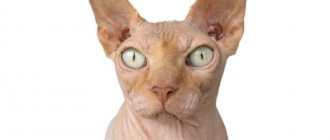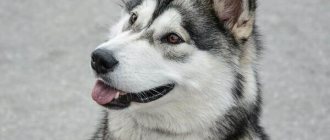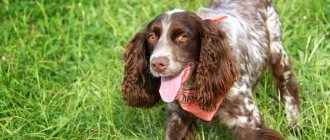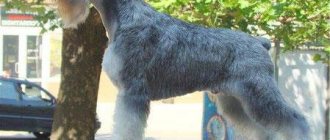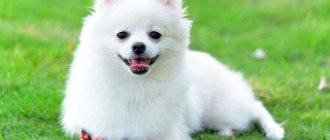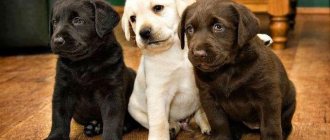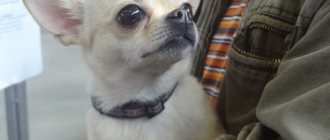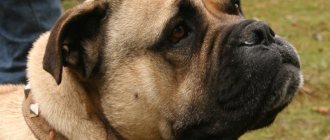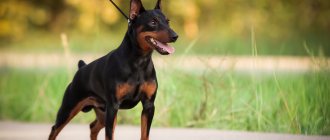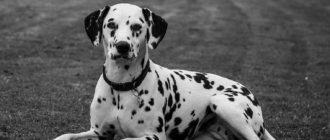The Komondor, also known as the Hungarian Shepherd, is one of the most ancient dog breeds. Initially, this is a wolfhound, a guardian of sheep flocks, but today it is increasingly being adopted as a companion who, if necessary, will protect family and property. The Komondor has the heaviest coat in the world; its weight in an adult dog can reach 7 kg.
History of the breed
The first memories of this breed are found among the Magyar tribal people. These tribes inhabited the lands adjacent to the Black Sea. Large dogs served as shepherds for sheep, and also protected herds from attacks by wild animals. From the middle of the 9th century, the Magyars were ousted by the Khazar Khaganate. As a result, the tribes migrated to the lands of modern Hungary.
Since then, the breed has received another name - the Hungarian watchdog. Some researchers claim that this breed first appeared in ancient Tibet, and they came to the western territories along with nomadic peoples. But there is no official confirmation of this theory.
According to the official version, the Hungarian watchdog was the result of crossing wolves and ancient shepherd breeds. But there is another legend that says that the Komondor is the son of a sheep and a wolf.
Since the beginning of the 16th century, memories of this breed can be found in the book “The History of King Astyagis”. In this work, the commander is described as a dog that guards the herds. Michael Klein's book, published in the 18th century, describes how local residents hunt wild predators together with Komondors.
During World War II, the breed's population declined significantly. Fascist soldiers killed these pets during farm robberies, as the dogs defended their territory to the death.
Features of the Komondor
A distinctive characteristic of the Komondor is its white coat color, as well as its interesting “hairstyle”. For many centuries, these dogs were shepherds and guardians for sheep. According to external data, such a dog looked like a lamb, but was radically different from a wolf.
The herding lifestyle also affected the character of modern dogs. The Komondor, like many guard breeds, has an innate distrust of strangers, and aggressive behavior can be observed. But after a few minutes the dog will become quite friendly if the new acquaintance does not pose a threat.
When describing the characteristics of representatives of this breed, it is necessary to note their mental abilities. This dog easily recognizes people with whom he may have come into contact several years ago. Komondors behave like puppies for a long time; they are always happy to play and frolic. This is due to the long period of growing up. Adult dogs are distinguished by their willful and independent disposition. They are quite independent and do an excellent job without constant supervision and instructions from a person.
Komondor sizes
Komondors are a large breed. Visually, the dog appears larger due to its thick and long coat. According to the size, the height of the dog varies between 65–80 centimeters. Males are slightly taller - from 70 to 75 centimeters at the withers. The average height of a Komondor female is 65–70 centimeters.
Representatives of this breed weigh little. An adult dog weighs between 30 and 50 kilograms. It is important for the Komondor to maintain the correct weight, because in order to fulfill its purpose, the animal must be mobile. A significant portion of the pet's weight is made up of fur.
Features of the Komondor's coat
A distinctive feature of the Komondor's appearance is its thick coat, which forms long curls. Dogs even have long hair covering their eyes. There may be an opinion that through such “veils” the animal does not see anything, but this is not so. Long bangs protect the pet's eyes from excess sun rays, and long thick curls of fur protect the body from rain, cold and bites of wild predatory animals.
Until the age of two, dogs' fur does not curl into tight cords. Puppies have a soft and wavy coat that gradually becomes curly and forms curls as the animal matures.
The coat of an adult Komondor weighs at least seven kilograms, and approximately two thousand cords can be counted on its body. Owners of Hungarian Shepherds need to be prepared for special care for their pet's coat.
Distinctive features
Hungarian Shepherds look extraordinary. Not only do they reach 70 cm at the withers , but their thick, unusual coat adds volume to the dog. The dog's weight varies from 45 to 80 kg, 8 kg may be wool .
Hungarian kennel clubs try to prevent Komondors from being bred as show dogs . They carefully monitor the working qualities of the dogs and do not improve their appearance. Although in other European countries and America these shepherd dogs take an active part in show programs.
In general, Komondors give the impression of being giant dogs with strong bones and a well-developed muscular structure. The latest standard was approved in 1994 , according to it all individuals that do not meet the characteristics of appearance and character are discarded.
- The head is long with a convex wide skull. The stop is well expressed. The brow ridges are developed.
- The muzzle is of medium length (the ratio to the length of the head is 2:3), wide, rough, and does not taper towards the nose. The bridge of the nose is straight, perpendicular to the head. The jaws are strong and strong, with a scissor bite. The lips and palate should be black or dark grey.
- The nose is large, round with open nostrils. Color – only black.
- The eyes are almond-shaped, medium in size, not set too deep. The color of the iris is dark brown. Covered with dense fur.
- The ears are triangular in shape, medium in size, hanging down to the sides of the head. The landing is average.
- The body is strong and muscular. The back is short and level, the loin is wide, the croup is sloping. The withers are clearly defined. The chest is well descended (deep). The stomach is tucked, but not lean. The neck is short, set at an angle of 35°, and horizontal when at rest.
- The tail is straight , of medium length, lowered below the line of the back, and does not rise above 90°.
- The limbs are straight and parallel, the muscles of the hind limbs are better developed. The hock joints are slightly arched. Elbows parallel to the body. Cat paws with collected toes. The claws are strong, the color, like the pads, is black. The movements are sweeping and graceful.
- The coat is long, takes the form of strands similar to that of a teenager, and can grow up to 25 cm; by the age of 5, growth slows down. Puppies have a soft and fluffy coat with a good undercoat. The dog tends to shed its fur.
- The color is only white, puppies can have a cream tint.
Personality of the Hungarian Shepherd
The Komondor is a guard breed whose character fully corresponds to its purpose. Dogs are courageous and vigilant, loyal to their owner, but do not get along well with other pets in the house.
Hungarian Shepherds have a calm, reserved character and a sharp mind. They are quite cunning, so from the first days they try to establish their own rules in the house. The owner needs to curb the complex nature of the pet. The dog owner's task is to earn authority and constantly maintain it.
Komondors are kind, active, and enjoy playing outdoor games. They need love and attention. But they can be aggressive towards a stranger, considering him a potential ill-wisher. This breed tends to bark loudly and for a long time to scare away strangers from its possessions.
Owner reviews
Ruslan E.: “The Hungarian Shepherd is my dog, we understand each other, as they say, perfectly. Of course, it didn’t come right away, we had to seriously work with the dog, but he is very smart.”
Anton G.: “This is a dog with character. Give me some slack - it will sit on your neck, and this is, after all, 50 kg! A Komondor needs a strong owner.”
Julia T.: “I love my Komondor and that’s the only reason I can endure his molt. True, the family where we got him from as a puppy reassures him that the problem will disappear when the baby grows up. I am waiting!".
How to raise a pet
Representatives of the Komondor breed are highly trainable. It is worth starting classes at approximately two months. Training a puppy requires logical and consistent actions from the owner. It is better to conduct classes in the form of a game. You need to be careful with punishments; use of brute force is allowed only when absolutely necessary. The best effect comes from rewarding your pet for completing a command.
It is worth remembering that Komondors clearly follow commands in normal circumstances, but under extreme circumstances they will act independently. By suppressing the desire to make decisions independently, you can make the dog useless and bullied.
Training
The dog is an excellent learner, but it is recommended to train it in a playful way: boredom is the animal’s enemy and makes it stubborn. Therefore, training should be diluted with interesting and exciting tasks. When your pet correctly follows commands, you need to praise and encourage him, and for disobedience and mischief, you should clearly and clearly scold him, but without shouting or physical force.
This is a working breed that requires physical and mental stress. When keeping the pet in a city apartment, the owner must spend a long time outside with the pet, walking or exercising.
How to choose a puppy
Hungarian Shepherds are a very rare breed. Therefore, prices for purebred Komondor puppies start at $1,000. Dogs with a famous pedigree will cost more. To purchase a puppy, it is recommended to contact specialized nurseries. Small Komondors are very similar to South Russian Shepherds and Royal Poodles. Therefore, when buying a pet secondhand, you risk getting a different breed.
You need to buy a Hungarian Shepherd puppy between one and two months of age. The animal must have all the necessary vaccinations. Little Komondors adapt better to new conditions and quickly remember family members.
Health
The Komondor has fairly good health. However, the dog is predisposed to the following diseases.
- Hip dysplasia.
- Bloating.
- Entropy.
- Skin diseases.
- Eye diseases.
Preventive measures to protect your Komondor puppy
- To keep your Komondor puppy completely safe, you first need to minimize his contact with unfamiliar dogs, especially stray dogs. Therefore, you should not let your dog off the leash, as in this case it will become impossible to control its behavior and communication with other dogs. Since a dog can easily become infected with distemper from simply touching the nose of a sick animal. This disease can be transmitted to a dog through sniffing. Your dog can become infected with trichophytosis from contact with the lichen-affected fur of a sick dog. Naturally, it is impossible to completely exclude a dog’s communication with other dogs, since it must be socialized. Therefore, try to find friends with dog lovers who look after their animals. By adhering to this rule, you can eliminate the risk of pathogen transmission by 80%.
- You should walk your dog in places where there are no landfills. Since garbage very often attracts rodents, which in turn are very often carriers of various infections. Gray rats are especially dangerous because they carry such a serious disease as leptospirosis.
- You should not allow your dog to sniff other people's feces, as they are a source of worms.
- Monitor your Komondor's health. Pay attention to even the most minor changes in his behavior. For example, your dog may appear lethargic, lose his appetite, or have a dry nose. Or you may notice that the dog begins to shed, and this has nothing to do with seasonal shedding. If hair loss becomes excessive, this is the first symptom indicating health problems in your pet. And only you can help him. Therefore, it is important to take the dog to the veterinary clinic in time, where the disease can be overcome for sure. In no case should you ignore the symptoms, since advanced infections are much more difficult to treat, and sometimes even impossible. If you start treating your dog, the disease can lead to his death or he will develop serious complications that will affect his hearing, vision, limbs and much more.
Getting ready for a puppy
Early separation from its mother will be stressful for your pet, so surround it with attention and care and do not leave it alone during the first five days. The puppy needs a personal space. Be sure to buy special toys, because with a Komondor puppy, the furniture in the house will suffer.
From the age of one year, the Komondor can be moved into its own kennel. These dogs are strictly prohibited from being kept on a chain or in a cramped enclosure. Without freedom, they will grow up aggressive and uncontrollable.
The coat of small Komondors does not require special care. You can bathe them when they get dirty and comb them periodically. You can feed your puppy with special high-quality food. When feeding naturally, bones, fatty and smoked foods, and sweets are prohibited. Until the age of two months, the dog requires feeding five times a day, from 2 to 4 months four times, and from six months to a year - three times.
Commander's food
There are a few large Hungarian Shepherd dogs. You can feed her both natural products and dry food. Commanders are unpretentious when it comes to nutrition and enjoy eating meat, vegetables, fruits and cereals. An adult pet should be fed twice a day.
The number of feedings for puppies depends on their age:
- Up to one and a half months, young dogs should eat 5 times a day.
- From one and a half months to six months - 4 times a day.
- From six months to one year - 3 times a day.
It is better to feed puppies with specialized food that can provide the growing body with the necessary minerals and vitamins.
If the diet of an adult commander consists of natural products, then you should know what not to feed this breed:
- Bones can damage your pet's teeth, so it's best to avoid them. In order for the dog to sharpen its teeth, special bones are purchased at the pet store.
- A dog's stomach does not digest fatty meat well, so pork should not be given to it. Shepherd dogs are fed chicken or beef.
- The breed's body does not digest lactose, and therefore only cheese and cottage cheese can be given to the pet from dairy products.
- A delicacy such as chocolate can lead to the development of intestinal diseases. You can easily replace it with various special treats from the pet store.
If the commander eats dry food, he will lose about one kilogram per day. Do not forget to pour clean water for your pet, which should always be freely available to him.
Rules of care
The Komondor's coat needs to be washed at least three times a year. Since a dog's fur can repel water, such procedures require a lot of effort and time. An experienced groomer will need about eight hours. It is not recommended to bathe a dog in winter, because its fur takes at least two days to dry.
There is no need to comb an adult dog; cleansing and separating the strands is done by hand. Komondors shed in the spring and autumn. They do not scatter the wool, it remains on the strands. These dogs are clean and do not have a strong odor.
Walk
The Commander dog breed will require constant exposure to fresh air and physical activity. If the owner of the animal lives in an apartment, then every day it is necessary to walk the pet for at least 2 hours. While walking, it is important to keep your dog on a leash to avoid unpleasant situations.
Walking your dog must be on a leash only
Pros and cons of the breed
Among the advantages of this breed are:
- Good security qualities.
- Strength, endurance.
- Kindness, calmness.
- Ease of training.
- Devotion.
- Positive attitude towards children.
But representatives of the Komondor breed also have some disadvantages. The disadvantages include the following features:
- Possible aggression towards strangers and other dogs.
- Stubbornness, desire for dominance.
- Difficulties in caring for the coat.
Socialization
The breed's high intelligence allows it to quickly absorb information and respond to environmental factors. At the same time, the pet loves everything new, so when choosing the same type of training, the commander quickly begins to get bored. The consequence of this may be a refusal to carry out the owner’s commands. Therefore, during training sessions, it is necessary to captivate the pet with new information.
During training, it is recommended to use only the “carrot” method. Praise and affection develop positive qualities in the breed, but an aggressive parenting style can lead to the development of bitterness and aggression in the pet.
Gender differences also affect dog training. Bitches are more obedient and pliable, while cables are stubborn. From an early age, it is recommended to socialize the Komondor: introducing him to new people and dogs. Lack of communication with the “environment” can lead to the development of aggressiveness in the breed. The Komondor is a children's best friend. The pet bravely tolerates any games with children and will selflessly protect them in any situation.
Pets get along well with other animals in the family. The commander takes everyone under his protection. Reacts indifferently to other people's children and animals.
Interesting Facts
- Despite the fact that the dogs are called Hungarian Shepherds, this country is not their homeland. The nomadic tribes who were the first owners called them “Cumans”. The Europeans changed this name to “kuman dor”, which literally translates as “Polovtsian dog”.
Wikipedia – the word “komondor” comes from the Italian “cane commodore”, and is translated as “king of dogs”.
- The ancient Komondor breed has only been officially recognized since 1920. This year the dogs took part in the European exhibition for the first time as a separate breed. After which a standard for the Hungarian Shepherd was created.
- Komondors are one of the rarest breeds in the world. This fact is explained by the difficulty of keeping such a pet in an apartment. About three thousand of these dogs are registered in their native Hungary, and less than 1 thousand Komondors live in our country.
- The Komondor is very similar in appearance to the Hungarian Puli Shepherd, which is smaller in size and has a different origin story.
Mating
- Breeding large dogs is hard work. Most often, breeders are either experienced specialists themselves or invite them to carry out the procedure. Puberty occurs at 8-12 months , but mating is allowed only at 20 months , so that the organisms of both dogs can conceive and bear healthy offspring.
- The bitches should already be in their third heat, mating is carried out 13-15 days from the beginning, when the loop swells greatly and the discharge becomes lighter. Since the Komondor population is small, almost all matings are breeding. Pets are cleaned of helminths and checked for pathologies.
- You need to walk the dogs together and see their reaction. If they have accepted each other, then you can move on to the second part: the girl is brought to the dog’s territory. There should be a lot of free space to make the pets comfortable. The act lasts 15-20 minutes , the lock from 5 to 40 . When locking for a long time, you need to choose a position so that the shepherd dogs are not injured. Repeated mating is carried out after 2 days.
